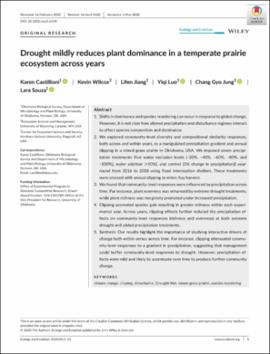| dc.contributor.author | Castillioni, Karen | |
| dc.contributor.author | Wilcox, Kevin | |
| dc.contributor.author | Jiang, Lifen | |
| dc.contributor.author | Luo, Yiqi | |
| dc.contributor.author | Jung, Chang Gyo | |
| dc.contributor.author | Souza, Lara | |
| dc.date.accessioned | 2020-07-10T19:26:55Z | |
| dc.date.available | 2020-07-10T19:26:55Z | |
| dc.date.issued | 2020-06-01 | |
| dc.identifier.citation | Castillioni, K., Wilcox, K., Jiang, Lifen, Luo, Y., Jung, C.G. & Souza, L. (2020). Drought mildly reduces plant dominance in a temperate prairie ecosystem across years. Ecology and Evolution, 10(12). doi:10.1002/ece3.6400 | en_US |
| dc.identifier.uri | https://hdl.handle.net/11244/325159 | |
| dc.description.abstract | 1. Shifts in dominance and species reordering can occur in response to global change. However, it is not clear how altered precipitation and disturbance regimes interact to affect species composition and dominance.
2. We explored community‐level diversity and compositional similarity responses, both across and within years, to a manipulated precipitation gradient and annual clipping in a mixed‐grass prairie in Oklahoma, USA. We imposed seven precipitation treatments (five water exclusion levels [−20%, −40%, −60%, −80%, and −100%], water addition [+50%], and control [0% change in precipitation]) year‐round from 2016 to 2018 using fixed interception shelters. These treatments were crossed with annual clipping to mimic hay harvest.
3. We found that community‐level responses were influenced by precipitation across time. For instance, plant evenness was enhanced by extreme drought treatments, while plant richness was marginally promoted under increased precipitation.
4. Clipping promoted species gain resulting in greater richness within each experimental year. Across years, clipping effects further reduced the precipitation effects on community‐level responses (richness and evenness) at both extreme drought and added precipitation treatments.
5. Synthesis: Our results highlight the importance of studying interactive drivers of change both within versus across time. For instance, clipping attenuated community‐level responses to a gradient in precipitation, suggesting that management could buffer community‐level responses to drought. However, precipitation effects were mild and likely to accentuate over time to produce further community change. | en_US |
| dc.description.sponsorship | Open Access fees paid for in whole or in part by the University of Oklahoma Libraries.
This study was financially supported by NSF Office of Experimental Program to Stimulate Competitive Research (OIA‐1301789) and Office of the Vice President for Research, University of Oklahoma. | en_US |
| dc.language | en_US | en_US |
| dc.rights | Attribution 4.0 International | * |
| dc.rights.uri | https://creativecommons.org/licenses/by/4.0/ | * |
| dc.subject | Climate Change | en_US |
| dc.subject | Clipping | en_US |
| dc.subject | Disturbance | en_US |
| dc.subject | Drought-Net | en_US |
| dc.subject | Species Reordering | en_US |
| dc.subject | Mixed-grass Prairie | en_US |
| dc.title | Drought mildly reduces plant dominance in a temperate prairie ecosystem across years | en_US |
| dc.type | Article | en_US |
| dc.description.peerreview | Yes | en_US |
| dc.identifier.doi | 10.1002/ece3.6400 | en_US |
| ou.group | College of Arts and Sciences::Department of Microbiology and Plant Biology | en_US |

